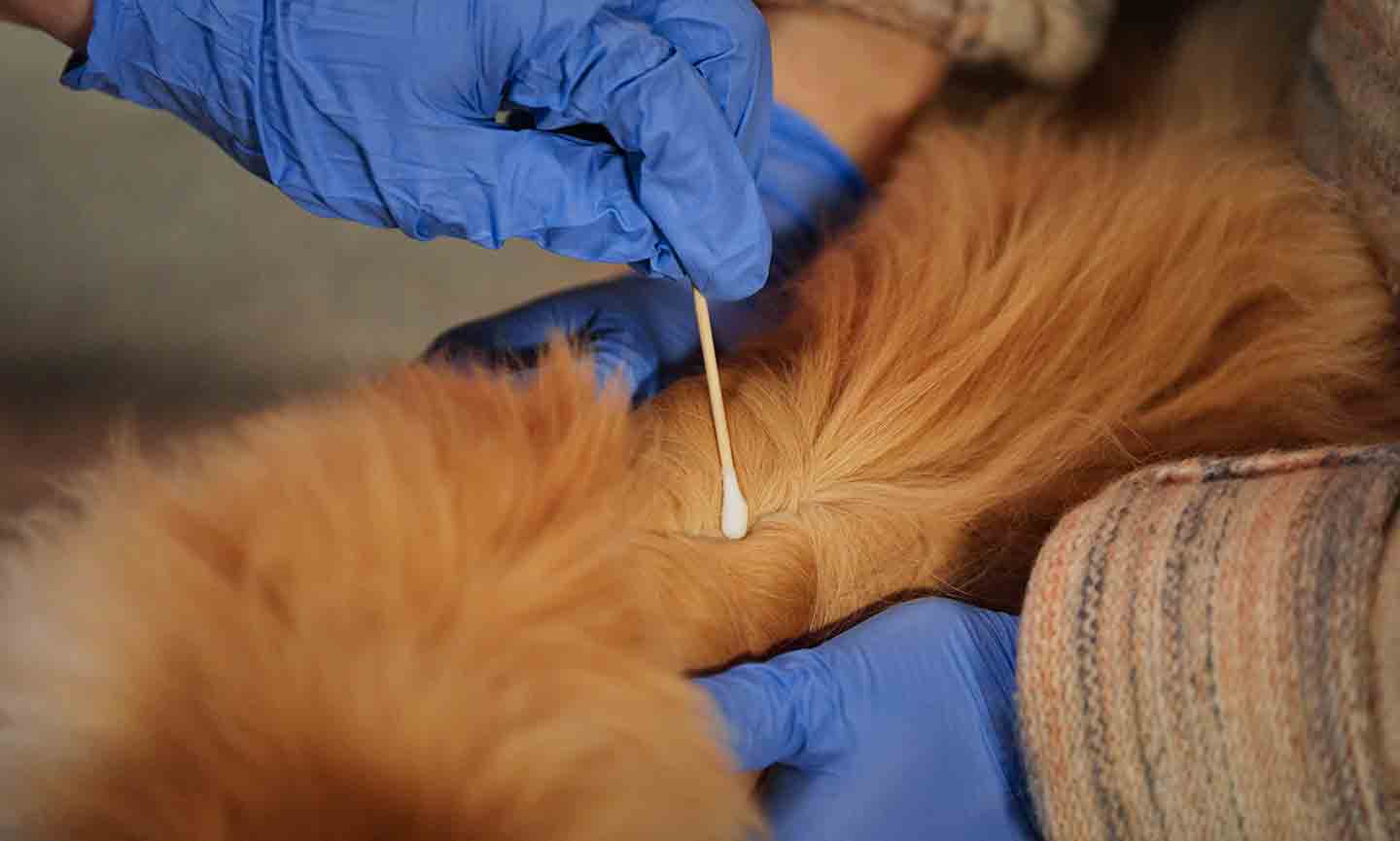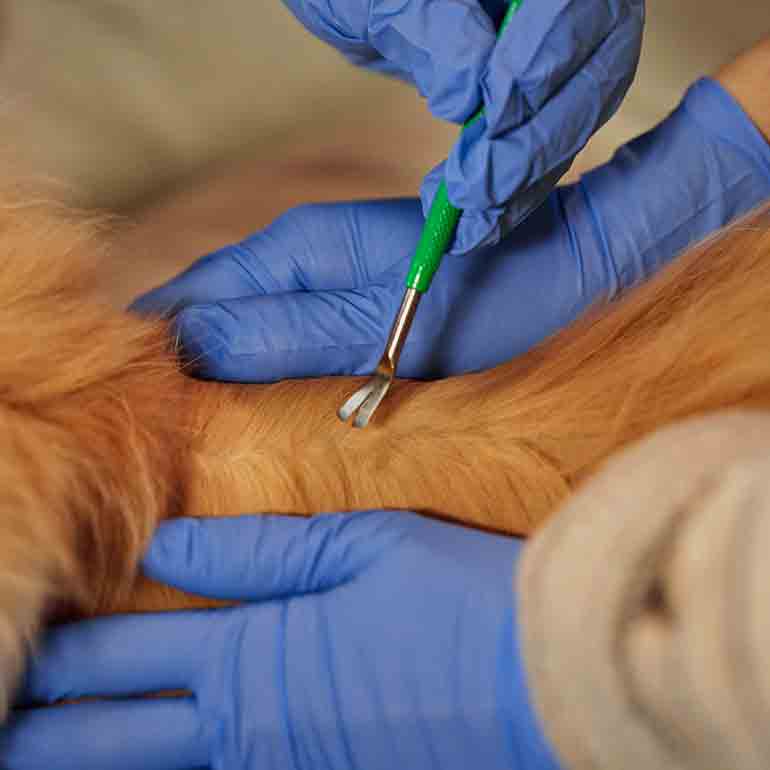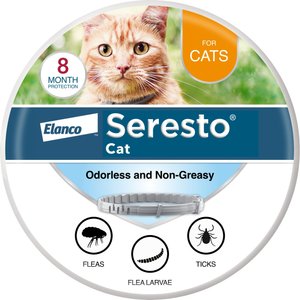If you’ve found a tick on your cat, you’re likely concerned about your pet’s health—and ready to remove that sucker ASAP. Today, we’re showing you how with expert insight offered straight from veterinarians.
With their help, we’re teaching pet parents common signs of ticks to look for and offering a step-by-step guide on how to effectively remove ticks from your cat’s body. We’re also sharing some common mistakes people make when removing ticks from their pet’s skin and providing pro tips on tick prevention to help keep your feline safe and healthy.
In This Guide
How To Get Rid of a Tick on Your Cat: A Step-By-Step Guide
If you think you’ve found a tick on your cat’s skin, then you’ll want to take the proper steps to remove it. Having this pet health know-how is important, as removing only the body of the tick—leaving the tick’s head behind—can lead to discomfort or a risk of infection.
“In general, cats are much less likely to have attached ticks than dogs. This is because cats are fastidious groomers and often remove ticks themselves,” says Jamie Whittenburg, DVM, director of Kingsgate Animal Hospital in Lubbock, Texas.
Indoor cats are even less likely to have ticks, unless you live in a wooded area or location where there’s a high number of ticks. However, cats can get ticks and fleas, and tending to them promptly is important for their comfort and safety.
“Ticks can transmit disease to both cats and humans, and the risk increases with increased time attached to the host,” Dr. Whittenburg says, so it’s essential to find these bugs and remove them fast. Follow these steps.
1Confirm It’s a Tick
Before making any big moves, first make sure that it’s a tick you’re dealing with. Dr. Whittenburg says that anytime you see a small, dark mass or lump on your cat’s body, it’s important to closely inspect it so you know what you’re dealing with.
“Ticks are small arachnids with eight legs and biting mouthparts. The head will be buried into the cat’s skin and the hind end of the tick should be freely moveable,” she says.
If in doubt, never pull out the tick yourself. Dr. Whittenburg says it’s common to mistake nipples, skin tags and other skin masses for ticks. Pulling at them can be painful for your feline and cause injury. So, if you’re not 100 percent sure, take your cat to the vet.
2 Gather Necessary Supplies
Here’s what you’ll need to remove a tick from your cat’s body:
- Plastic or latex gloves
- A tick removing tool or pair of tweezers
- Feline-friendly antiseptic such as Duoxo S3™ wipes
- Treats to help distract your kitty and/or reward them for good behavior
- A friend to help hold your cat still
- Container with a lid and isopropyl alcohol
- Towel (optional)
There are several types of tools you can use to remove a tick from a cat, including:
- Tweezers with a slanted edge
- Plastic tick scoops, like the Summit® Tick Take Tool
- Metal tick keys or cards, like the TickCheck® Wallet Sized Tick Removal Card
- Plastic tick twisters, such as the ZenPet™ Tick Tornado®
Tweezers
Easily sterilized; can work on any size tick, any location on the body and any fur type
You may accidentally pinch or grab your cat’s skin
Plastic tick scoops
Easy to use
Not easily sterilized; less effective at removing small ticks
Metal tick keys or cards
Easily sterilized; work well for large ticks
Not as effective for small ticks; can be challenging to use on certain body parts, such as armpits
Plastic tick twisters
Work well on all sizes of ticks
Not easily sterilized, can be challenging for cats with long fur
3Hold Your Cat Still
We’ll be straightforward with you: Your cat probably isn’t going to like this process one bit. Enlist a friend to help hold your cat still while you remove the tick.
“To hold the cat still and to reduce the chance of injury to both the cat and [pet parent], this should be a two-person job,” Dr. Whittenburg says. “It can be helpful to wrap the cat snugly in a towel to make them feel safe and to aid in them being still. Treats can also be offered to the cat to distract them.”
If your cat is anxious or struggles, stop and consult your veterinarian. Also, make sure that both parties are wearing plastic gloves, as ticks carry disease that can affect humans too.
4Grasp the Tick With Your Tool
To remove a tick from a cat, you need either a tick removing tool or fine-tipped tweezers. Try something like TickCheck Tick Remover or Summit Tick Take Tick Remover Tool. If you are using a tool, be sure to follow the specific instrument instructions as they may vary on how to pull (straight or rotate) and remove the tick. Dr. Whittenburg says the tick should be firmly, but gently, grasped as close to the surface of your cat’s skin as possible.
5Remove the Tick
Begin by applying steady, gentle pressure away from the cat. Ideally, Dr. Whittenburg says, the tick will release its mouthparts and come away intact.
Be careful not to squeeze too tightly during removal, she adds, as this could cause the tick to release infected saliva into the pet’s body and potentially increase the risk of tick borne-disease such as Lyme disease. Also be sure to remove the tick’s head and mouthparts so they don’t stay lodged in your pet, which can create inflammation or infection at the site.
How To Remove a Tick From Your Cat’s Ear, Mouth or Head
Your cat’s ears, mouth and head are all very delicate areas and prone to injury. There’s also a strong chance your cat won’t allow you anywhere near these sensitive spots, or they may jerk around quite a bit once you start digging for a tick. For that reason, Dr. Whittenburg recommends scheduling an appointment with your veterinarian to get rid of cat ticks in these spots.
She says there are also other times when you should consult a veterinarian versus removing the tick yourself:
- The tick is very small. (This makes it hard to grasp it with a pair of tweezers.)
- You’re dealing with a tick infestation, meaning there are multiple ticks versus just one.
- The tick is located near the eyes, nose, mouth, ears or genitals.
- Your cat is in distress and/or won’t allow you to remove the tick.
- The tick’s head wasn’t removed, and it isn’t expelled within five days.
How To Remove a Tick Without Tweezers or a Tick Removal Tool
If you don’t own a pair of tweezers or a proper tick removal tool, then you should purchase these items first before attempting to get rid of this pest. Other things people use, such as eating utensils or grooming tools, aren’t ideal for removing the whole tick and can lead to injury or infection.
“The biggest mistake people make is that they don’t grab the tick as close to their pet’s body as possible. Tweezers or a tick removal device will help get as close to the skin as possible,” says Amber Karwacki, DVM, a veterinarian with Heart + Paw in Philadelphia, Pennsylvania.
Tweezers or tick removal tools are inexpensive and easily found at convenience stores or pet shops. We recommend putting together a pet first-aid kit full of everything you may need for situations like these.

What To Do After Removing Ticks From Your Cat’s Skin
- Examine the tick and the site of the bite. Carefully inspect the removed tick to make sure you pulled out the tick’s head along with its body. Look at the site of the bite on your cat’s skin, too, for any leftover tick parts. If you see them, make an appointment with your veterinarian for removal.
- Properly dispose of the tick. Do not handle the tick with your bare hands. To kill ticks, you can put them in a sealed container with isopropyl alcohol. You may want to save the container with the tick as your vet may want to see it.
- Clean the area. After removing the tick, thoroughly disinfect the tick bite area using a feline-friendly antiseptic such as Duoxo wipes. Alternatively, you can use soapy water and a clean cloth. Just make sure to rinse afterward to prevent soap residue, which can be irritating.
- Monitor your cat for any signs of illness or infection for several weeks. Redness or swelling could indicate a skin infection or other health issue. Also keep an eye out for jaundice (yellowing in their eyes or ears), as well as behavior changes such as lethargy or reduced appetite. If you have any concerns, take your cat to the vet.
What Not To Do
The above veterinarian-approved protocol on how to get rid of ticks is the best process for properly removing this problematic pest from your sweet feline. The vets we spoke to said other “home remedies,” like the ones below, aren’t remedies at all—they’re less effective and can even be harmful to cats:
- Covering the tick in petroleum jelly: This DIY technique is messy and not foolproof. “Creams and Vaseline® on the tick will not cause it to release from the skin,” Dr. Karwacki notes. It also makes it more difficult to grasp onto the tick when you try to remove it with tweezers or a tick removal tool.
- Burning the tick with a match or cigarette: This is dangerous and has the potential to burn your cat’s fur or harm their body, Dr. Karwacki says.
- Covering the tick in nail polish: This isn’t necessary and can cause irritation on your cat’s skin.
- Digging the tick out: “Do not try to dig the tick out of the skin with anything sharp, as that can cause more harm than good,” Dr. Karwacki says.
Tick Prevention Tips for Cats
The best way to keep ticks off of your furry friends is flea/tick prevention medications. Some of the products that Dr. Karwacki recommends include:
- Oral medications like Bravecto® and NexGard®
- Topical treatments like Frontline® Plus
- Flea collars like Seresto® Tick Collar for Cats
Some of these medications can also kill ticks currently on your cat’s body, which may eliminate the need for removing the ticks with tweezers. Speak with your veterinarian about the best approach for your pet.
Along with medications, it’s also best to keep your cat indoors, as ticks tend to hang out in the great outdoors. This is particularly true in wooded areas or locations with tall grasses or overgrown vegetation. If your kitty loves basking in the wind and sun, consider installing a screened catio.
Now you know how to protect your cat from ticks—but are they safe from fleas too? Find out everything you need to know about flea treatment and prevention for cats.
Expert insight provided by Jamie Whittenburg, DVM, veterinarian director at Cat World and the director of Kingsgate Animal Hospital, a full-service pet hospital in Lubbock, Texas; and Amber Karwacki, DVM, a veterinarian with Heart + Paw Animal Hospital in Philadelphia, Pennsylvania.
This content was medically reviewed by Chewy vets.
Protect Your Cat From Pests
Share:
























